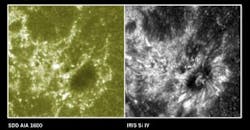NASA telescopes images of mystery region of the Sun
This past summer, NASA’s Interface Region Imaging Spectrograph (IRIS) telescope orbited around the Earth andcaptured images of the mysterious lowest layers of the sun’s atmosphere, which scientists and researchers on the team hope to use in order to gain more information on the uncharted area.
NASA’s IRIS carries an ultraviolet telescope combined with an imaging spectrograph. It contains four identical back-side thinned 1024 x 2048CCD image sensors with 13 µm x 13 µm pixel size. The sensors, from e2v, are customized versions of commercially available sensors. IRIS also uses two cameras from the Solar Dynamics Observatory helioseismic and magnetic imager / atmospheric imaging assembly, which were developed by the Rutherford Appleton Laboratory.
The images captured of this particular region of the sun showed thin, fibril-like structures which have never been seen before, showing enormous contrasts in density and temperature occurring throughout the region. The images also show spots that rapidly bright and dim, which provides information on how energy is transported and absorbed throughout the region, according toNASA.
It is the hopes of the IRIS research team that the images will help track how magnetic energy contributes to heating in the sun’s atmosphere. It is important to understand this region of the sun because it forms the ultraviolet emission which impacts near-Earth space and the Earth’s climate. In addition, energy traveling through the region helps drive solar wind, which can affect satellites, power grids, and GPS systems on Earth during extreme space weather.
The IRIS Observatory was designed and the mission managed byLockheed Martin. The Harvard-Smithsonian Center for Astrophysics built the telescope. Montana State University designed the spectrograph. NASA's Ames Research Center provides mission operations and ground data systems. NASA’s Goddard Space Flight Center manages the Small Explorer Program for NASA's Science Mission Directorate. The Norwegian Space Centre is providing regular downlinks of science data. Other contributors include the University of Oslo and Stanford University.
View more information on theIRIS telescope.
View a technical paper on IRIS instrumentation.
Also check out:
Hubble telescope captures images of most known distant galaxy
NASA releases striking new infrared and downward-looking images of Saturn
Filming a leap from the edge of space
Share your vision-related news by contactingJames Carroll, Senior Web Editor, Vision Systems Design
To receive news like this in your inbox,click here.
Join ourLinkedIn group | Like us on Facebook | Follow us on Twitter| Check us out on Google +
About the Author

James Carroll
Former VSD Editor James Carroll joined the team 2013. Carroll covered machine vision and imaging from numerous angles, including application stories, industry news, market updates, and new products. In addition to writing and editing articles, Carroll managed the Innovators Awards program and webcasts.
